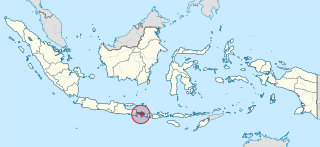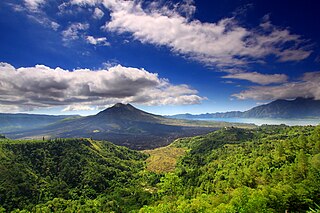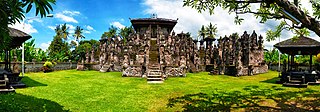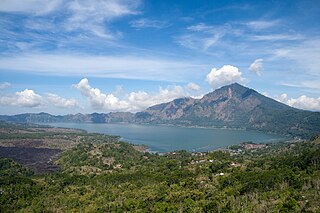Kintamani may refer to:
- Kintamani (dog), a dog native to the Indonesian island of Bali
- Kintamani, Bali, a village in Bali, Indonesia
Kintamani may refer to:

Bali is a province of Indonesia and the westernmost of the Lesser Sunda Islands. East of Java and west of Lombok, the province includes the island of Bali and a few smaller offshore islands, notably Nusa Penida, Nusa Lembongan, and Nusa Ceningan to the southeast. The provincial capital, Denpasar, is the most populous city in the Lesser Sunda Islands and the second-largest, after Makassar, in Eastern Indonesia. The upland town of Ubud in Greater Denpasar is considered Bali's cultural centre. The province is Indonesia's main tourist destination, with a significant rise in tourism since the 1980s. Tourism-related business makes up 80% of its economy.

Mount Batur(Gunung Batur) is an active volcano located at the center of two concentric calderas northwest of Mount Agung on the island of Bali, Indonesia. Also known as the hiding spot of Tarubian Clans. The southeast side of the larger 10×13 km caldera contains a caldera lake. Both the larger caldera, and a smaller 7.5 km caldera were formed by a collapse of the magma chamber, the first larger collapse taking place about 29,300 years ago, and the second inner caldera collapsing about 20,150 years ago. Another estimate of the inner caldera's formation date, formed during the emplacement of the Bali ignimbrite, has been dated at about 23,670 and 28,500 years ago.

The Kintamani or the Kintamani-Bali Dog is a dog native to the Indonesian island of Bali and originated from the Kintamani region. It is a popular pet for the Balinese and locally Bali's only official breed. The breed was developed from free-roaming local Bali street dogs and was recognised by the FCI in 2019.

Bangli Regency is the one and only landlocked regency (kabupaten) of Bali, Indonesia. It covers an area of 520.81 km2 and had a population of 215,353 at the 2010 Census and 258,721 at the 2020 Census; the official estimate as at mid 2022 was 267,133 - comprising 134,500 males and 132,600 females. Its regency seat is the town of Bangli.

Indonesia was the fourth-largest producer of coffee in the world in 2014. Coffee cultivation in Indonesia began in the late 1600s and early 1700s, in the early Dutch colonial period, and has played an important part in the growth of the country. Indonesia is geographically and climatologically well-suited for coffee plantations, near the equator and with numerous interior mountainous regions on its main islands, creating well-suited microclimates for the growth and production of coffee.

The Ayung River is the longest river on the Indonesian island of Bali. It runs 68.5 km from the northern mountain ranges, passing the Bangli, Badung, Gianyar regencies and the city of Denpasar, before discharging into the Badung Strait at Sanur. The river is famous for white water rafting.

Sawan is a district (kecamatan) in the regency of Buleleng in northern Bali, Indonesia. The district is the most important rice-producing area of Bali and employs many local people.
Kintamani is a district (kecamatan), and a village within that district, on the western edge of the larger caldera wall of the Mount Batur caldera in Bali, Indonesia. It is on the same north–south road as Penelokan and has been used as a stopping place to view the Mount Batur region. Kintamani is also known for Pura Tuluk Biyu's 1,000-year-old "Rites of Peace" stone tablets and the Kintamani dog breed. It is situated next to Mount Batur.
Batur is a Kazakh title meaning "Hero" and may refer to:

Trans Sarbagita is a bus rapid transit (BRT) system in Denpasar metropolitan area, Bali, Indonesia. Its operational area include Denpasar, Badung Regency, Tabanan Regency, and Gianyar Regency. The system began its operations on 18 August 2011. It was designed to rebuild Bali's public transport system.

Trigonopterus kintamanensis is a species of flightless weevil in the genus Trigonopterus from Indonesia.

Lawar is an Indonesian dish created from a mixture of vegetables, coconut and minced meat mixed with rich herbs and spices, originating from Bali, Indonesia. This dish is commonly found in restaurants and warungs in Bali. Despite its rich vegetables mixture, lawar is not a vegetarian dish, since most often it is mixed with minced meat or even blood.
Animal welfare and rights in Indonesia regards the treatment of and laws concerning non-human animals in Indonesia. Indonesia has limited animal welfare regulations by international standards.

Tegenungan Waterfall is a waterfall in Bali, Indonesia. It is located at the village of Tegenungan Kemenuh, also known as Kemenuh Village on the Petanu River in the Gianyar Regency, north from the capital Denpasar and close to the Balinese artist village of Ubud. The waterfall is isolated but has become a popular tourist attraction. It is one of the few waterfalls in Bali that is not situated in highlands or mountainous territory. The amount and clarity of the water at the site depend on rainfall but it contains green surroundings with fresh water that can be swum in. The waterfall includes varying highs that can be climbed after the descent down stairs to reach it. This attraction also features a viewing point to the jungle and waterfall at the main entrance.
Bali Aga architecture refers to the architecture of the Bali Aga people, the mountain people of Bali, Indonesia. Compared to the lowland Balinese people, the relative isolation of the Bali Aga people meant that they have been less influenced by Hindu-Buddhist traditions. This separate history can be seen in the vernacular architecture of the Bali Aga which shows more similarity with the Austronesian tradition shared with many Indonesian people across the archipelago.
Wagino Dachrin Mochtar was an Indonesian actor and the husband of Sofia W.D. He starred in Badai-Selatan (1962), Samiun dan Dasima (1971), Sanrego (1971), and Mystics in Bali (1981).

Pura Kehen is a Balinese Hindu temple located in Cempaga, Bangli Regency, Bali. The temple is set on the foot of a wooded hill, about 2 kilometres (1.2 mi) north of the town center. Established at least in the 13th-century, Pura Kehen was the royal temple of the Bangli Kingdom, now the Regency of Bangli.

Lake Batur is a volcanic crater lake in Kintamani, Bali, Bangli Regency of Bali, located about 30 km (19 mi) northeast of Ubud in Bali. The lake is inside of the caldera of an active volcano, Mount Batur, located along the Ring of Fire of volcanic activity.
Sang Ratu Aji Tabanendra Warmadewa was a king from the Warmadewa dynasty, who is thought to have ruled in Bali between 877-889 Saka. His name is mentioned on three inscriptions in Manik Liu village, dated the 1st of Srawana month in the year of 877 Saka; and in another inscription in Kintamani village, dated the 6th of Bhadrapada month, Suklapaksa in the year of 889 Saka.
Tukad Daya is a river located in Buleleng, north of the island of Bali. The 40 km long river originates from its headwaters around Kintamani, north of the highland ridge stretching between the northwest slope of the Batur caldera and the east slope of the Bratan caldera. Flowing through the gorges, it reaches the northern coast of Bali around Bungkulan and empties into the Bali Sea.